Scythe Infinity: 5 Heatpipes and Silent 120mm Fan
by Wesley Fink on February 26, 2007 12:05 AM EST- Posted in
- Cases/Cooling/PSUs
Scythe Infinity
Scythe Co., Ltd. is a Japanese company located in Tokyo. Beginning in 2002 Scythe started manufacturing and distributing products for the PC enthusiast. This included CPU cooling solutions. Scythe's first product, the Scythe Samurai, developed quite a reputation among computer enthusiasts.
Scythe produces a wide range of air cooling solutions for the computer enthusiast. There are currently about a dozen air cooling solutions detailed on the company website. These range from entry cooling solutions all the way to full cooling tower designs.
Their current catalog includes the well-known Scythe Infinity and the Scythe Ninja Rev. B full cooling tower solutions at the top. There are also mid to low-end offerings such as the Scythe Katana that was recently reviewed at AnandTech.
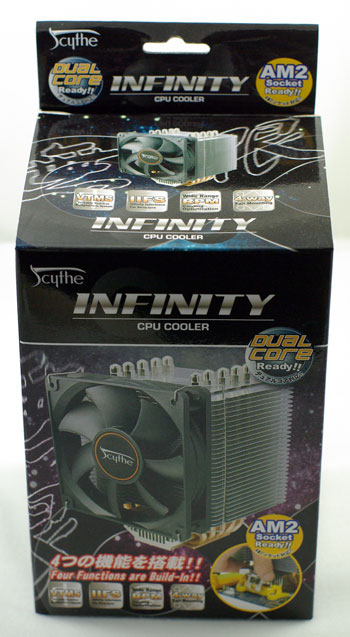
Scythe likes using colorful graphics, but they often put so much information in so many languages on the box that the packaging becomes confusing. The Infinity is a big heatpipe tower, and Scythe use every inch of that big package for information. You can find whatever you want to know about Infinity on the package somewhere - it's just finding what you are looking for is not so easy in that package information explosion.
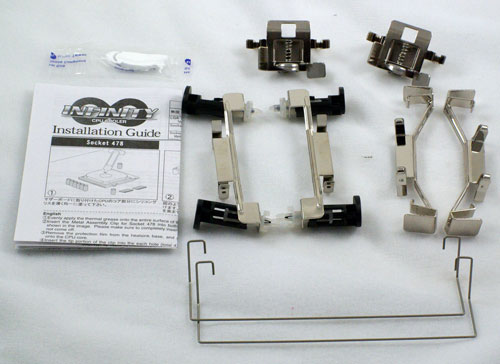
Infinity comes with adapters for 775, AM2, and AMD 754/939/940. The Scythe adapter system is extremely easy to use. Adapters pop into holes on the side of the tower base and no tools are needed for mounting the adapters. It's a very clever mount system.
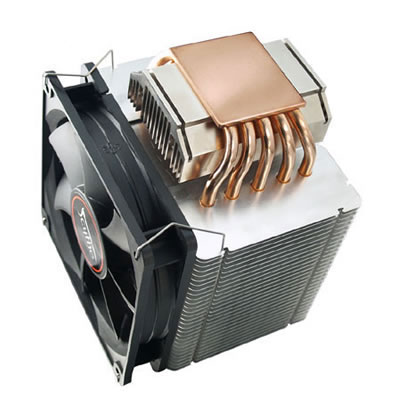
The mounting surface of Infinity is highly polished. It is protected during shipments with an adhesive film that removes leaving no residue.

At first glance it looks as if the Scythe Infinity uses ten heatpipes for cooling, but Scythe specifies the configuration as five heat pipes. The 5 pipes flatten out and pass across the base copper plate, so they form a continuous "U" shape with each heatpipe.
Scythe supplies a packet of very basic thermal compound with the Infinity, but it is nothing special. We used our standard silver-colored thermal grease in our testing, which is what we use in testing all coolers unless they supply a high-end thermal grease with the cooler.
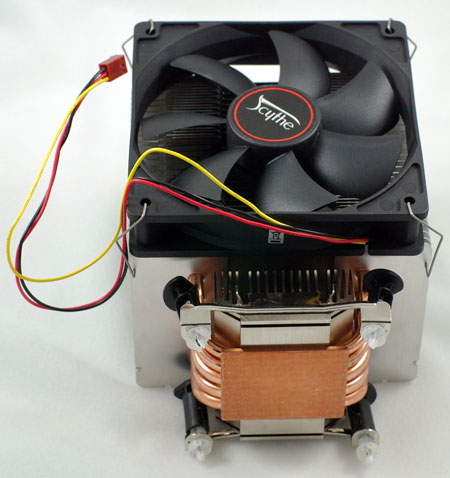
The included low-noise fan can fit on any of the 4 sides of the cooler. Scythe tells us mounting on the larger side of the Infinity provides the best cooling, but the fan may also be mounted on the shorter side if that works better in your configuration.
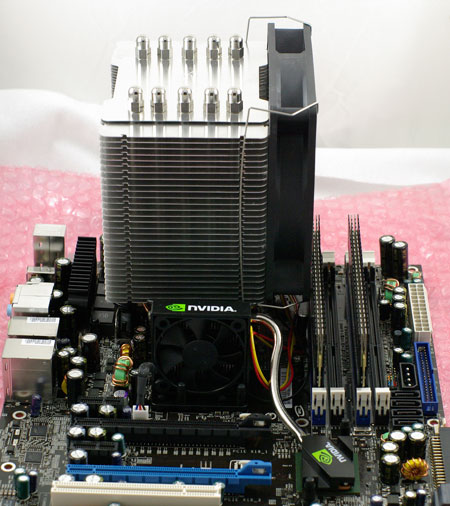
Installation is very easy after the mounting plate is installed. The 775 mount uses push pins - just like the Intel retail design. However easy the mount is, the fact that the Infinity weighs right at 2.2 lbs, or a kilogram, gives reason for pause. It is very uncomfortable having so much weight held by just those pop clips. The Infinity is probably OK in a desktop case, but it is not a mounting system that handles moving the case around or transport to and from a LAN party.
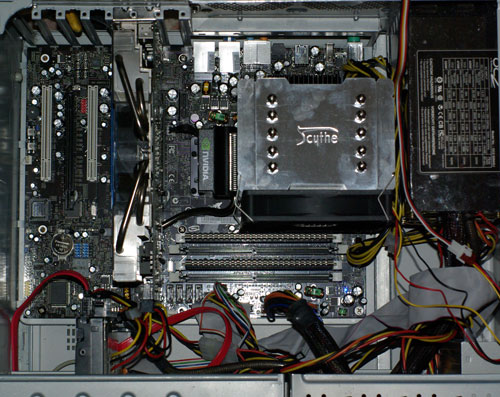
The Infinity does not overhang the DIMM sockets on the EVGA 680i as you can see in the picture above. The fan does come very close however. The mass of the Infinity is also a bit closer to the motherboard than some other heatpipe towers, so the Infinity can be a tight fit on some motherboards. In our installation the EVGA cooling fan on the Northbridge touched the Infinity, meaning the Infinity has to be very carefully aligned on installation. In our first attempt stock idle cooling was 36C, which appeared very high. After a careful remount the stock idle temp dropped to 31C, which was more in line with expected performance.
Specifications
Our test system is Intel Socket 775, but the Scythe Infinity will mount on any current CPU, as already mentioned. All the needed hardware is included to fit the supported sockets.
One 120mm "silent" fan comes with the Scythe Infinity. The Infinity street price is $58, about the same as the current price of the Tuniq Tower 120. If you cannot find a local retailer or etailer that sells the Infinity you can order directly from Scythe USA for $58. Scythe also sells additional fan wires for about $2 per pair. Many etailers also stock the fan wire kits. Any 120mm x 25mm fan should mount on the Infinity. Scythe also manufactures a very large variety of cooling fans sold under the Scythe brand, including models that feature the Sony Fluid Dynamic Bearing. You will find many of these available at etailers like Newegg, 3DCool and Frozen CPU.
Scythe Co., Ltd. is a Japanese company located in Tokyo. Beginning in 2002 Scythe started manufacturing and distributing products for the PC enthusiast. This included CPU cooling solutions. Scythe's first product, the Scythe Samurai, developed quite a reputation among computer enthusiasts.
Scythe produces a wide range of air cooling solutions for the computer enthusiast. There are currently about a dozen air cooling solutions detailed on the company website. These range from entry cooling solutions all the way to full cooling tower designs.
Their current catalog includes the well-known Scythe Infinity and the Scythe Ninja Rev. B full cooling tower solutions at the top. There are also mid to low-end offerings such as the Scythe Katana that was recently reviewed at AnandTech.

Scythe likes using colorful graphics, but they often put so much information in so many languages on the box that the packaging becomes confusing. The Infinity is a big heatpipe tower, and Scythe use every inch of that big package for information. You can find whatever you want to know about Infinity on the package somewhere - it's just finding what you are looking for is not so easy in that package information explosion.

Infinity comes with adapters for 775, AM2, and AMD 754/939/940. The Scythe adapter system is extremely easy to use. Adapters pop into holes on the side of the tower base and no tools are needed for mounting the adapters. It's a very clever mount system.

The mounting surface of Infinity is highly polished. It is protected during shipments with an adhesive film that removes leaving no residue.

At first glance it looks as if the Scythe Infinity uses ten heatpipes for cooling, but Scythe specifies the configuration as five heat pipes. The 5 pipes flatten out and pass across the base copper plate, so they form a continuous "U" shape with each heatpipe.
Scythe supplies a packet of very basic thermal compound with the Infinity, but it is nothing special. We used our standard silver-colored thermal grease in our testing, which is what we use in testing all coolers unless they supply a high-end thermal grease with the cooler.

The included low-noise fan can fit on any of the 4 sides of the cooler. Scythe tells us mounting on the larger side of the Infinity provides the best cooling, but the fan may also be mounted on the shorter side if that works better in your configuration.

Installation is very easy after the mounting plate is installed. The 775 mount uses push pins - just like the Intel retail design. However easy the mount is, the fact that the Infinity weighs right at 2.2 lbs, or a kilogram, gives reason for pause. It is very uncomfortable having so much weight held by just those pop clips. The Infinity is probably OK in a desktop case, but it is not a mounting system that handles moving the case around or transport to and from a LAN party.

The Infinity does not overhang the DIMM sockets on the EVGA 680i as you can see in the picture above. The fan does come very close however. The mass of the Infinity is also a bit closer to the motherboard than some other heatpipe towers, so the Infinity can be a tight fit on some motherboards. In our installation the EVGA cooling fan on the Northbridge touched the Infinity, meaning the Infinity has to be very carefully aligned on installation. In our first attempt stock idle cooling was 36C, which appeared very high. After a careful remount the stock idle temp dropped to 31C, which was more in line with expected performance.
Specifications
Our test system is Intel Socket 775, but the Scythe Infinity will mount on any current CPU, as already mentioned. All the needed hardware is included to fit the supported sockets.
| Scythe Infinity Specifications | |
| Heatsink | |
| Dimensions | 116(L) X 125(W) X 160(H)mm (excluding fan) |
| Weight | 960g (including fan) |
| Material | Pure Copper and Aluminum |
| Fan Configuration | 4-way mount, up to four 120mm Fans can be mounted |
| Fan | |
| Fan Size | 120mm x 120mm x 25mm |
| Noise Level | 23.5 dB-A |
| Speed | 1200 rpm +/- 10% |
| Air Flow | 46.5 CFM |
One 120mm "silent" fan comes with the Scythe Infinity. The Infinity street price is $58, about the same as the current price of the Tuniq Tower 120. If you cannot find a local retailer or etailer that sells the Infinity you can order directly from Scythe USA for $58. Scythe also sells additional fan wires for about $2 per pair. Many etailers also stock the fan wire kits. Any 120mm x 25mm fan should mount on the Infinity. Scythe also manufactures a very large variety of cooling fans sold under the Scythe brand, including models that feature the Sony Fluid Dynamic Bearing. You will find many of these available at etailers like Newegg, 3DCool and Frozen CPU.










39 Comments
View All Comments
SmokeRngs - Wednesday, February 28, 2007 - link
The information you wanted is there. Why are you complaining? There are plenty of people that don't care about the information you want but do want the information you deride. Both are there in a clear and concise manner for those that want to see one or both.
shabby - Monday, February 26, 2007 - link
People who buy $50 heatsinks dont buy them because they're quiet, they buy them so they can overclock their cpu's. Plus they probably stick higher cfm fans, so they're not quiet anymore.Zambien - Monday, February 26, 2007 - link
I disagree. When I bought my Zalman 7700cu for my current PC, the main reason was that it would provide similar cooling to my current HSF, with less noise. I didn't like the fact that my computer sounded like a jet engnine. I'm sure some people fall into the category, but others do not.cujo - Monday, February 26, 2007 - link
why wouldn't you test with overclocks?arswihart - Monday, February 26, 2007 - link
Not to mention they are talking about 50Mhz differences in OC to separate better and lesser performing heatsinks. Come on, that isn't even a significant difference. Did they repeat the result on multiple systems, or just the one. Does it matter? Of course not.arswihart - Monday, February 26, 2007 - link
A heatsink doesn't do anything magic to give you higher OC's, it gives you lower temps, which will then let you OC higher.Measuring a CPU's OC is looking at data that is a step removed from what you should be looking at, which is simply the temperature. I could care less what they get to OC to, it will be almost certainly different for anyone who buys the heatsink.
The only thing that I think is worth taking away from any heatsink review is: installation caveats, temps, and noise.
shabby - Monday, February 26, 2007 - link
I find it funny that the infinity cant beat the tt120, does it have thicker heatpipes or what. What part of the tt120's construction make it better then other beefier/bigger coolers?Superdoopercooper - Monday, February 26, 2007 - link
The first rule in A-B testing is to hold EVERYTHING constant except for the items being examined/tested.Therefore, in ALL of your heatsink reviews, the system down to the THERMAL COMPOUND should remain fixed, even if the heatsink ships with some "higher end" stuff.
I think it would be wise to pick ONE thermal compound and use it on EVERY heatsink test. Then you are testing the performance of the heatsink (i.e. Heatsink #1 is better than Heatsink #2, with no exceptions), and not the thermal grease + heatsink.
I would hate to think that heatsink #1 was the best, but only because it shipped with better compound than another. I think many people ponying up for these higher-$$ heatsinks will pony up $6 for some good thermal grease.
Then, if you want to do an additional test that comments on the performance of the included thermal grease, that would/could be helpful to potential buyers.
Wesley Fink - Monday, February 26, 2007 - link
I can easily link you to a review from a respected source that proves toothpaste and Kraft Vegemite are superior in cooling to Arctic Silver 5 :-) I have tested many thermal compounds and found little differnece among the quality products. That conclusion was a rude awakening for me. I have found much more variation in perfromance in how the thermal grease was applied than I have ever found in the thermal compounds themselves.Thus far, all of the tests have used our standard silver-colored (but no real silver content) tube thermal compound except the Thermalright MST 6775 and the Zalman pair. These came with top thermal grease, and yet none of the three beat our Tuniq or this Infinity. If the cooler company cares enought to supply a premium thermal compound we test with that compound.
Superdoopercooper - Monday, February 26, 2007 - link
If it is true that all thermal compounds are nearly equal, then I guess that's fine. I would like to see the link, actually.That still doesn't change the fact that the best A-B testing holds EVERYTHING constant except the single item being tested.
Since AT is the site I hold in the highest regard in terms of info on computer components, I thought I'd just throw up my $0.02 on ways to maybe make these tests "better" and/or more scientific.
Could just be my test engineering background talking. :-P